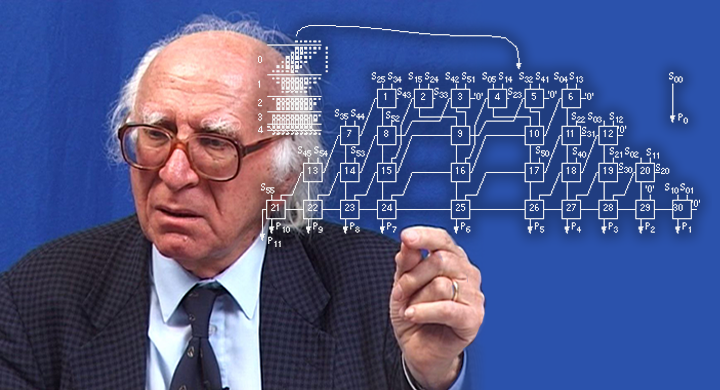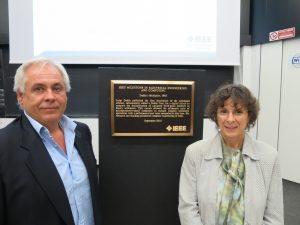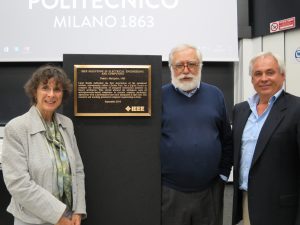
Dadda’s Multiplier Milestone
City of Milan (Politecnico di Milano)
29 September 2016
Barry L. Shoop, 2016 IEEE President
Hello and good afternoon to everyone. Thank you all for coming, and being a part of this very special IEEE Milestone dedication at Politecnico di Milano.
It is a pleasure to join you today in one of Italy’s—and the world’s — foremost universities for science and technology education.
I would like to extend special thanks to our distinguished hosts, for their support of IEEE, and for all their hard work in making today’s dedication an exceptional event.
Dedicating an IEEE Milestone takes effort, and that effort comes from IEEE members throughout the IEEE Italy Section, the IEEE Italy Section’s Computer Society Chapter, and the world. The many volunteers involved in the Dadda’s Multiplier Milestone are to be commended for their generous contributions of time, energy, and expertise in making today’s Milestone a reality.
As President and a long-time member of IEEE, as an electronic engineer, and as an engineering educator, I am always honored and humbled when presented with the opportunity to recognize a fellow educator who has distinguished themselves as one of technology’s true legends.
On occasions such as this, Newton’s famous quote from his 1676 letter to Hooke always seems to come to mind: “If I have seen further, it is by standing upon the shoulders of giants.”
IEEE’s history includes a wealth of giants of technology, from former organizational presidents like Bell, Hewlett, and Weston, to Nobel Prize winners like Marconi, Shockley, and Boyle.
Today, we come together to recognize yet another giant—IEEE Life Fellow Luigi Dadda. Professor Dadda was an innovator whose work has provided broad shoulders upon which future generations of technologists have stood, and continue to stand. There are few equals amongst giants like Professor Luigi Dadda, and none more deserving of recognition through the establishment of a permanent IEEE Milestone.
IEEE Milestones represent great moments throughout our world’s long history of technical innovation.
That is one of the key reasons that IEEE feels it is important to recognize these pioneering events, and the people behind them. They serve as landmarks in the progress of technology…and in the progress of civilization.
The IEEE Milestones in Electrical Engineering and Computing program sponsors and manages the process for selecting Milestones such as the one we are dedicating today. The Milestones Program began in 1983 as part of IEEE’s Centennial Celebration.
Since those first Milestones were dedicated more than 30 years ago, IEEE Milestones have honored and preserved nearly 200 unique and pioneering efforts.
These include some of the world’s most widely known and consequential technical achievements, across three centuries of technological progress.
They start with Benjamin Franklin’s work in London and Alessandro Volta’s invention of the electric battery in the 18th century.
They continue with the IEEE Milestones of the 19th century—such landmarks as the demonstration of practical telegraphy by Shilling and Morse, the first practical system for using alternating electrical current, and Popov’s early contributions to wireless communications.
And they continue into the 20th century with the pioneering work on the ENIAC and RAMAC computers, the invention of the Transistor, and many, many more.
The recognitions of such achievements continue with today’s Milestone dedication.
Professor Luigi Dadda was one of Italy’s—and Europe’s—true computer engineering pioneers.
In addition to his leadership here at the Politecnico di Milano, Professor Dadda chaired Italy’s Committee for Science and Technology. He was instrumental in the establishment of the Universita della Svizzera Italiana, and was a founding member of Italy’s premier computing association, the Associazione Italiana per il Calcolo Automatico, as well as Italy’s exceptional journal of computer science, the Rivista di Informatica. Professor Dadda proposed that Europe create a European Information Network, a visionary idea that was implemented by the European Union. In short, his was a life dedicated to research, to education, and to advancing technology to benefit humanity.
As impressive as all of those accomplishments are, however, they do not fully convey the impact that Professor Dadda has had upon our world.
In the 1960s, computers were evolving rapidly. So, too, were processor architectures. With that, however, came the need for faster high-speed arithmetic circuits, and international research began to focus on proving the design of parallel digital multiplier circuits.
In 1965, Professor Luigi Dadda published his seminal contribution to the design of optimized parallel digital multipliers for fixed-point binary numbers. Professor Dadda’s revolutionary idea was to defer and distribute the summation of the carry bits in the partial product matrix of floating point multiplication. This groundbreaking approach reduced the number of additions, and thus helped to reduce propagation delay—all of which significantly decreased the number of logic gates used by a circuit.
This breakthrough in computer arithmetic—Dadda’s Multiplier, the Milestone we gather to salute today—was original, revolutionary, and the cornerstone of many of the advances in computer arithmetic that followed. The Dadda scheme for parallel multipliers would become known as the “Dadda Tree”; even at the present time, it remains one of the only recognized structures for arithmetic circuits.
Today, students everywhere around the world encounter Dadda’s Trees in every textbook and university course on computer arithmetic. As a fellow engineering educator, I believe that the inclusion of his work as a foundational educational element is one of the accomplishments that Professor Dadda might have treasured the most.
The work done by Professor and IEEE Life Fellow Luigi Dadda here at Politecnico di Milano was truly an advancement of technology in Italy, and in the world. And as a technological advancement of such impact, that would have been enough to make it worthy of today’s IEEE Milestone dedication. But what makes IEEE Milestones unique is that the technology we recognize has to have been of benefit to people, to a society, or to humanity itself.
The Milestone we commemorate today at Politecnico di Milano changed modern computing. Professor Luigi Dadda’s Multiplier made computers better, faster, and able to accomplish ever-greater tasks. In so doing, his work helped to reshape our modern world. Thanks to his extraordinary vision in 1965, the advances made in computing have caused sea changes within every facet of modern life, from education, to health care, to public safety, and to countless other fields of interest in our world.
Milestones like Luigi Dadda’s Multiplier remind us of the contributions of our profession, and the strides made by countless technologists as they sought to advance technology to benefit humanity.
They demonstrate to their local community how engineers, scientists, and technologists have contributed not only to that community, but to our global community, helping to build today’s technologically advanced world.
Today’s event marks not only a single accomplishment, but echoes centuries of technological innovation.
And, now, I’d like to read the citation:
Dadda’s Multiplier, 1965
Luigi Dadda published the first description of the optimized scheme, subsequently called a Dadda Tree, for a digital circuit to compute the multiplication of unsigned fixed-point numbers in binary arithmetic. This circuit allowed the arithmetic units of microprocessor-based computers to execute complex arithmetic operations with a performance/cost ratio unequaled at that time. His research and teaching pioneered computer engineering in Italy.


